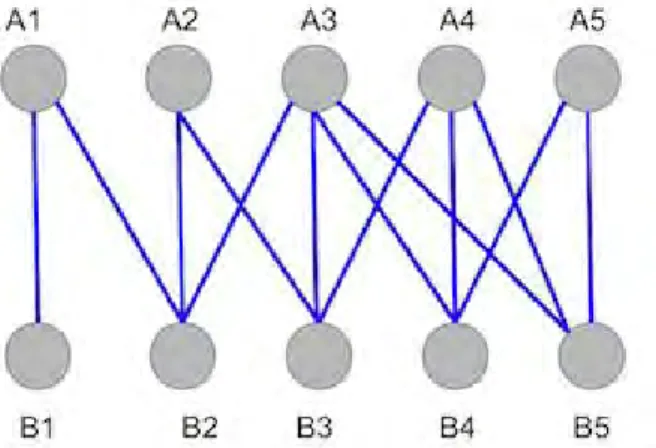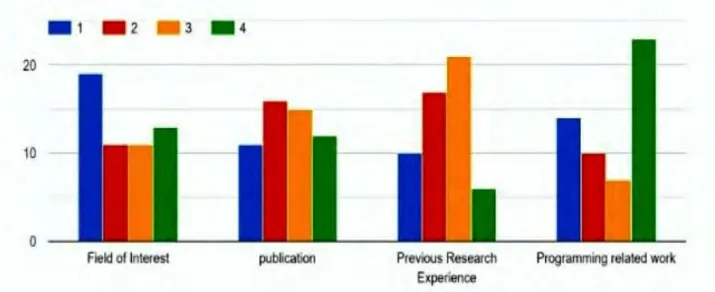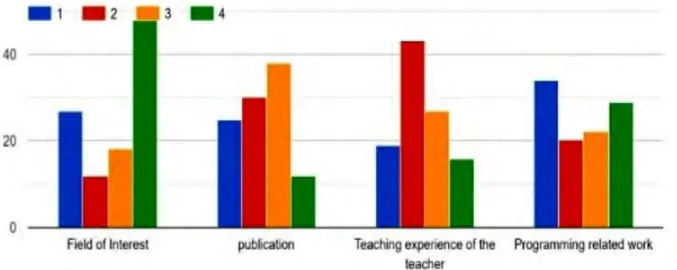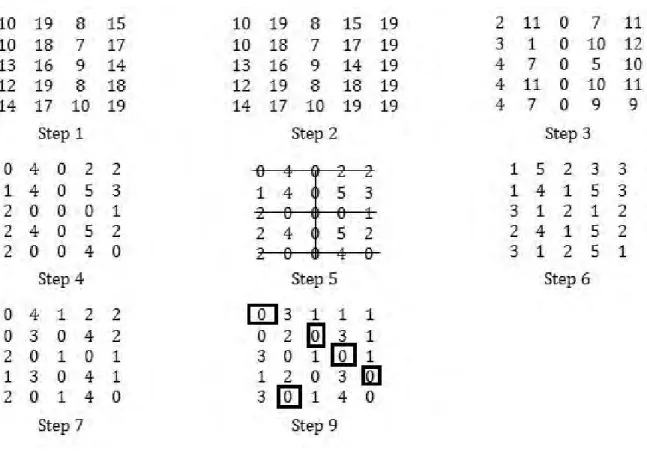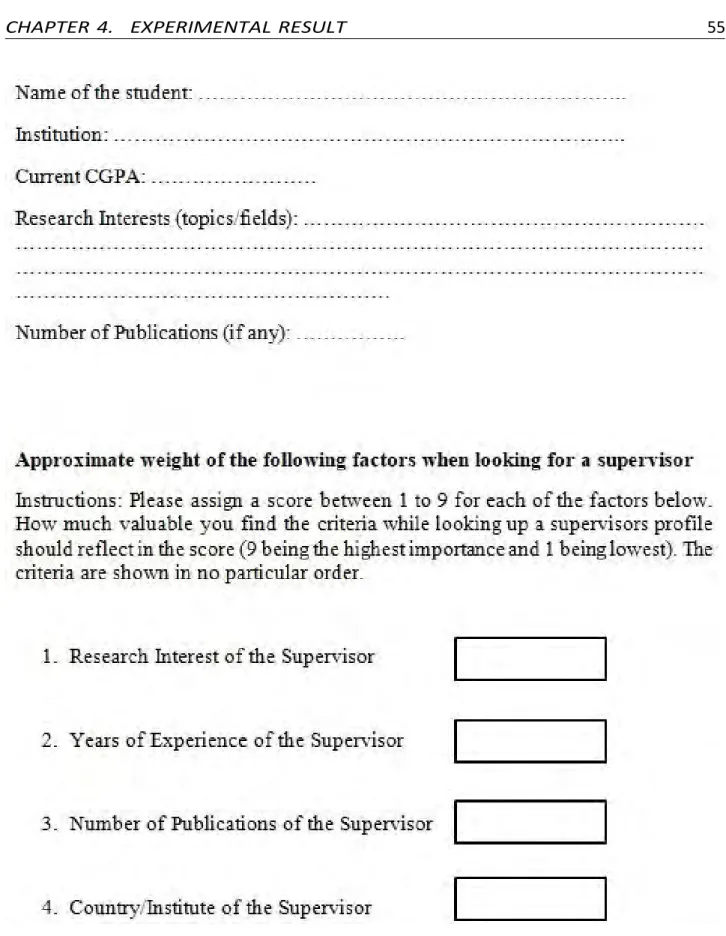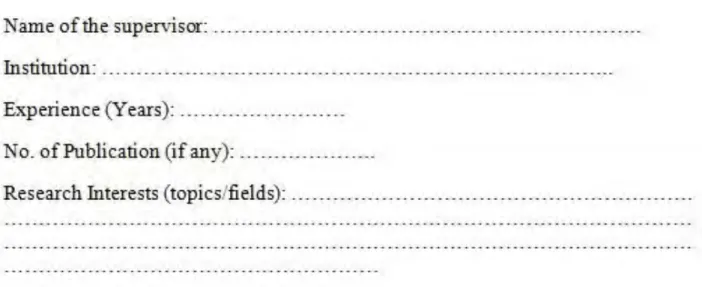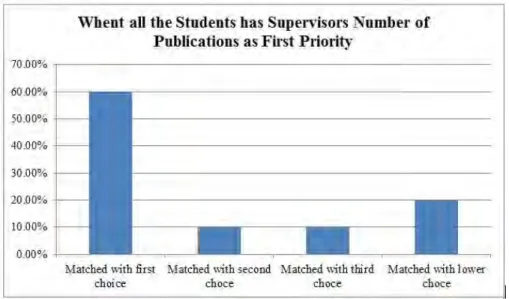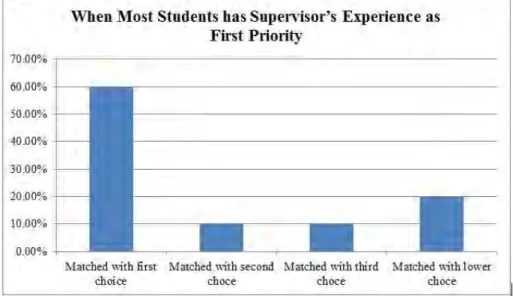At the same time, more options pose more challenges for the students and educators, while narrowing the list of potential fellows. This eventually yields a customized list of potential matches for each of the students and supervisors and the problem becomes a linear single objective optimization problem.
Introduction
Current Trends
Get more than just a qualification While much of the value of an undergraduate degree is in the qualification itself, perhaps the most important reasons for attending graduate school are the professional skills you'll gain, the personal development you'll achieve and the useful connections you'll make with other graduate students, academics and industry professionals. Even if you are someone who wants to contribute to the world in any field, professionally or academically, you will need to know your subject inside out.
Background
Better financial prospects are also a popular answer to the question "Why go to graduate school?" – although it may not necessarily be the most important factor, it still helps to find better financial prospects in the work sector with a recognized degree. Similar problems are addressed in various works where the matching criteria are more than one [10].
Motivation
Since there is a lack of any kind of ranking in the initial data, a suitable ranking can be created from these criteria and constraints for both student and supervisor using Analytic Hierarchy Process (AHP) which provides a method of to quantify weights of the criteria [ 19, 20]. Using this ranking, a comparison matrix can be created from which the strength of any student-supervisor match is calculated using the Technique for Order of Preference by Similarity to Ideal Solution (TOPSIS) method [21].
Objectives of This Thesis
Our Contributions
Organization of the Thesis
Literature Review
Similar Problems
REVIEW OF LITERATURE 9 may be completely undesirable by the same element if another criterion is considered. So it can be completely undesirable because of the same element if another criterion is considered.
Matching Algorithm
Bipartite Matching
Here, the participating agents can be divided into two disjoint sets and each member of one set ranks a subset of the members of the other set in order of preference. Here, the participating agents form a single homogeneous set and each agent ranks a subset of the others in order of preference.
Maximum-Weight Bipartite Matching
Some Popular Matching Algorithms
Roth [40] showed that with respect to the human-oriented Gale-Shapley algorithm, telling the truth is a dominant strategy for the men. Let C be a coalition of agents who falsify their preferences, and denote by I' the preference lists that result (every agent not in C has the same preference list in I and I').
![Figure 2.2: Example of Gale–Shapley Algorithm [1]](https://thumb-ap.123doks.com/thumbv2/filepdfnet/10866384.0/23.893.131.761.549.943/figure-2-2-example-gale-shapley-algorithm-1.webp)
Student-Project Assignment
This leads to the first variant of SPA, namely the Student-Project Allocation problem with supervisor preferences over students (SPA-S) [12], in which each supervisor S ranks in order of preference the students who find acceptable at least one project that S offers. In the student-project allocation problem with supervisor preferences over Student-Project pairs (SPA-(S,P)), each supervisor S has a preference list that depends not only on the students who find acceptable a project offered by S, but also the particular Ss projects these students would undertake.
Multi-objective Matching Problems
61] proposed NSGA-II, a well-known GA scheme for estimating Pareto-optimal solutions in multi-objective problems. Of the various techniques available to solve MOPs, multi-objective evolutionary algorithms (MOEAs) are the most popular, mainly due to their flexibility and ease of use.
Decision Making and Ranking
Allocation of junior doctors in Scotland (applicants' “scores” based on academic performance and assessment of application forms result in regular preferences for hospitals) [46, 66]. School choice in New York and Boston (kids have "priorities" based on factors like whether they're within walking distance and whether they already have siblings in school, and those priorities translate into regular preferences for schools) [22–24]. ]. P2P network (measurements of download/upload bandwidth, latency and storage capacity give rise to regular preferences of nodes in a communication network over their peers.
Analytical Hierarchy Process (AHP)
Al Harbi [71] applied AHP in the field of project management to select the best contractor. The planning objective was to design and evaluate a model that would effectively assist in health care system planning. AHP plays a crucial role in breaking down and prioritizing these various goals and criteria in the planning scenario.
Technique for Order of Preference by Similarity to Ideal So- lution (TOPSIS)
A hierarchical AHP structure is designed for the necessary composition and selection of the exam problem. The distance of each alternative from the fuzzy positive ideal solution (FPIS) and fuzzy negative ideal solution (FNIS) with respect to each criterion is calculated using FTOPSIS steps, then the results of the distance of all alternatives from FPIS and FNIS are obtained as Sj+ and Sj - for 10 alternatives. In addition, TOPSIS has been successfully used in recent years in the fields of human resource management [85], transportation [86], product design [87], manufacturing [88], water.
Conclusion
Proposed System
PROPOSED SYSTEM 28
System Definition
Ranking System
Major Factors while Ranking the Students
PROPOSED SYSTEM 29 progress of the candidate, mentoring, coaching in the research topic, research methodology, and
In their research [96] the authors tried to find out the roles and skills of supervisors from the perspective of the supervisors themselves. The result or grade obtained by the student during his/her course of studies, the student's area of research interest or expertise, and his/her previous experience in research or publication. Figure 3.1 shows the result of the survey done during the university thesis by Humayara Binte Rashid and Annita Tahsin Priyoti [97] on the thesis supervisors of the CSE department of BUET.
Explanation of selecting the Criteria that Influences Ranking of the Students
PROPOSED SYSTEM 31 Area of Research Interest
So when a supervisor admits a student, he/she is more concerned about the students' area of interest as it will be easier to motivate a student if he/she feels a close connection to the research topic. A supervisor who has years of research experience as a student and later as a supervisor would generally like to work with someone who already has some ideas about the topic he or she is going to work on rather than with a student whom the supervisor has to build from beginning. This is why a supervisor is highly influenced by the target student's area of interest or the area he/she has already worked with in their previous educational life.
Major Factors while Ranking the Supervisors
PROPOSED SYSTEM 33 for majority of the students programming related work got the majority of the vote and ranked
It is important for a student to choose a research area that is interesting to him/her academically as well as personally. Ideally, a student's research area should relate to his/her future career path and potentially contribute to the achievement of their career goals. PROPOSAL FOR SYSTEM 34 Discussing the idea with others When looking for a research area, it is important for one.
PROPOSED SYSTEM 35 environment sometimes largely depends on the geographical position and the weather of that
Problem Formulation
PROPOSED SYSTEM 36
Finding Suitable Match
Proposed Solution
Ranking the Students
- Finding Weight of the Factors for Supervisors
- PROPOSED SYSTEM 37
- PROPOSED SYSTEM 38
- Scoring the Students
- PROPOSED SYSTEM 39 higher the score is the more desirable a match that student is for the supervisor
- Creating a Score Matrix for Students
- PROPOSED SYSTEM 40 D. Normalizing the Score Matrix
The student's number of publication(s) is multiplied by the weight of publication and added to the score. The student's CGPA is multiplied by the weight of CGPA and added to the score. Next, each value of the score matrix is divided by the highest value to find a normalized score matrix.
Ranking the Supervisors
- Finding Weight of the Factors for Students
- PROPOSED SYSTEM 41
- PROPOSED SYSTEM 42
- Scoring the Supervisors
- PROPOSED SYSTEM 43
- PROPOSED SYSTEM 44 C. Creating a Score Matrix for Supervisors
- Normalizing the Score Matrix
In this final step of student ranking, the score matrix values are normalized to bring them into the range between 0 and 1 using the following steps. The number of publications of the supervisor is multiplied by the weight of the publication and added to the score. In this final supervisor ranking step, the score matrix values are normalized to bring them into the range between 0 and 1 using the following steps.
Ranking from both sides
PROPOSED SYSTEM 45 but himself/herself is too low in that parties rank, the absolute value of the dif-
Calculating Strength of the Match using TOPSIS Method
PROPOSED SYSTEM 46
Matching Students and Supervisors using Kuhn-Munkres Al- gorithm
Steps of AHP Method
PROPOSED SYSTEM 47
Steps of TOPSIS Method
Then the Euclidean distances from the positive ideal solution A+ and the negative ideal solution A− are calculated for each alternative Ai and Bj, as The relative proximity of Ci for each alternative Ai and Bi to the positive ideal solution is calculated. The best alternatives are those that have a higher value of Ci and should therefore be chosen because they are closer to the positive ideal solution.
Steps of Kuhn-Munkres Algorithm
PROPOSED SYSTEM 49
Conventionally, each element in the dummy row/column is the same as the largest number in the matrix.
Correctness of the Solution
So in this aspect, it is better to arrange the properties of each criterion in a specific range so that they are treated equally during the score calculation. In this way, it is ideal to define a satisfaction matrix where 2 defines the highest satisfaction between a pair and 0 defines the lowest satisfaction. Also, the satisfaction measurement decided in this way would not have provided a uniform and robust calculation strategy for pair strength.
Analysis of the Proposed Method
This chapter describes the algorithms and steps to find the weight matrix and score matrix for each student and supervisor. Finally, the assigned pairs are selected from the matrix in such a way as to minimize the total unhappiness of all matched pairs. In this chapter we will discuss our experimental results in a simulated environment.
Machine Configuration
Data Collection
EXPERIMENTAL RESULT 54 personal preferences while looking for a supervisor or selecting to mentor a student respectively
Second, we used the data collected by Humayara Binte Rashid and Annita Tahsin Priyoti on the thesis students of BUET's CSE department. Third, we used an online data source [112] that contains data in which students listed their favorite subject areas in order of preference. And they represent an average group of students and supervisors, with the student dataset containing students with different CGPAs and other qualities.
Creating A Scenario
EXPERIMENTAL RESULT 55
EXPERIMENTAL RESULT 56
EXPERIMENTAL RESULT 57 matched with a supervisor who matches most of his criteria will be a satisfactory match for
Performance Measurement Matrices
Satisfaction of the Student
Satisfaction of the Supervisor
EXPERIMENTAL RESULT 58
Satisfaction of the Matching
Some Relevant Experiments
EXPERIMENTAL RESULT 59 idea is to identify the solutions that contribute the most to the improvement of the performance
The first is that it generates a new solution from a unique neighborhood, i.e., the new solution cannot be generated by individuals from different neighborhoods. And, the second is that a new solution with a high fitness may replace some solutions, and then the population may lose diversity. However, both MOEA/D and MOEA/D-DE proposals generate a new solution, and then, they look at which subproblem the new solution is better than the current solution, but they do not consider the case where the solution of which was replaced can improve the solution of another subproblem, i.e., both algorithms assign the best individual to each subproblem independently, regardless of the globally best assignment.
EXPERIMENTAL RESULT 60 dynamically from the specific dataset that the system is working on
Results and Analysis of our Experiments
Measuring Weights of the Criteria
Satisfaction of the Students
- EXPERIMENTAL RESULT 61 When all the Students has Same First Priority
- EXPERIMENTAL RESULT 62 Publications as their first priority
- EXPERIMENTAL RESULT 63 When Different Students has Different First Priorities
- EXPERIMENTAL RESULT 64 However, a student with low CGPA but one or more published work will be ranked higher
- EXPERIMENTAL RESULT 65 area of interest or high number of publications are more likely to be matched with these desired
- EXPERIMENTAL RESULT 66
- EXPERIMENTAL RESULT 67
EXPERIMENTAL RESULT 61 When all the Students Have the Same First Priority When all the Students have the Same First Priority. In our experience, about 80% of students end up with their most favorable supervisor when all of their first priorities match the area of interest with the supervisor. In this case, more than 90% of the students will be selected to match their first or second most favorable supervisor.
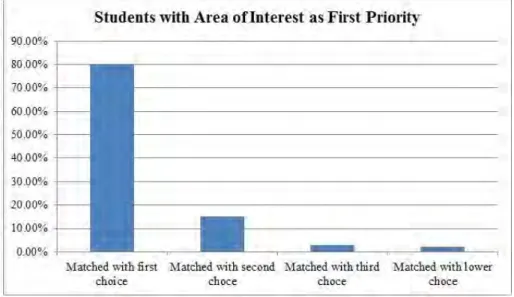
Satisfaction of the Match
Comparison with Other Algorithms
Stable Marriage Algorithm/Gale-Shapely Algorithm
EXPERIMENTAL RESULT 68 The graph in Figure 4.13 below shows that the possibility of students ending up with their
The same applies when the SM is applied from the supervisor's perspective; more than 70% of supervisors will ultimately receive their first choice, while the number of students who receive their first choice is well below 70%. But in both cases the number will drop below 20% if the supervisors and students all focus on the same type of criteria and rank one type of profile above all others.
Maximum Bipartite Matching Algorithm
Student-Project Allocation
EXPERIMENTAL RESULT 69 versa. But this algorithm follows the same path as the SMP and does not guarantee maximum
If we try the SPA algorithm from a student perspective, where students with better CGPA are first assigned to their chosen supervisors, then about 60% of students will end up with their chosen supervisor, but 40% of supervisors get the first student they want. On the other hand, if the SPA is applied from the supervisor's perspective, with most senior supervisors getting their picks first, only 55% of supervisors will get their first picks, but from the students' perspective, about 30 % are matched with their most desired supervisor. Similarly, if we choose a different criterion for the number of publications of the supervisors and match the supervisors with the most number of publications before others, then about 70% of the supervisors will get their chosen students, but from the perspective of the student, this number will be around 40%.
EXPERIMENTAL RESULT 70
Comparison with Similar Solutions
EXPERIMENTAL RESULT 71
Summary and Conclusion
Chapter 5
Conclusion and Future Work
Summary
CONCLUSION AND FUTURE WORK 73
From these factors we found a relative weight for each of the factors for each student and supervisor separately. Taking these two rank matrices, we calculated a third matrix showing the corresponding strength between each pair of student and supervisor, thus making the problem a linear single function problem. During the simulation, we ran the system with different student and supervisor preferences to determine the strength of the ranking system.
Future Works
Initially, we tried to find out the factors that affect the students and the supervisors individually. Using these weights, we created a ranking system for the students, where each student has a list of all supervisors cataloged from high to low preferences according to them. These preference lists are then fed into the Hungarian algorithm method to find the appropriate matches.
Bibliography
Mamman, “A Genetic Algorithm for Assigning Project Supervisors to Students,” International Journal of Intelligent Systems and Applications, vol. Munkres, "Algorithms for the assignment and transport problems," Journal of the Society for Industrial and Applied Mathematics, vol. Ohno, "Decision Support System for the Composition of the Examination Problem," European Journal of Operational Research, vol.
